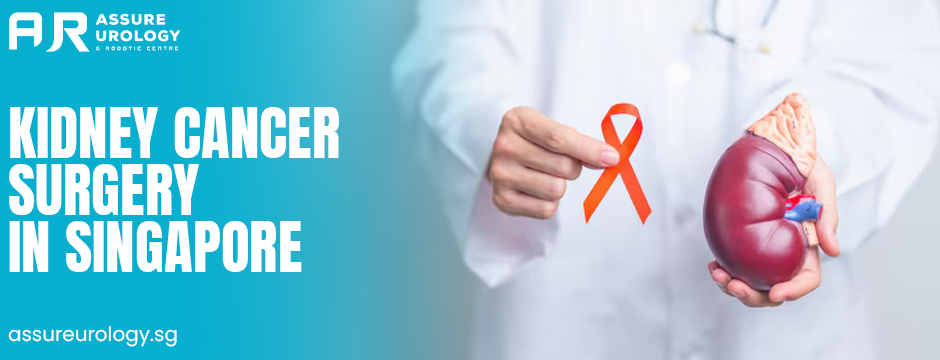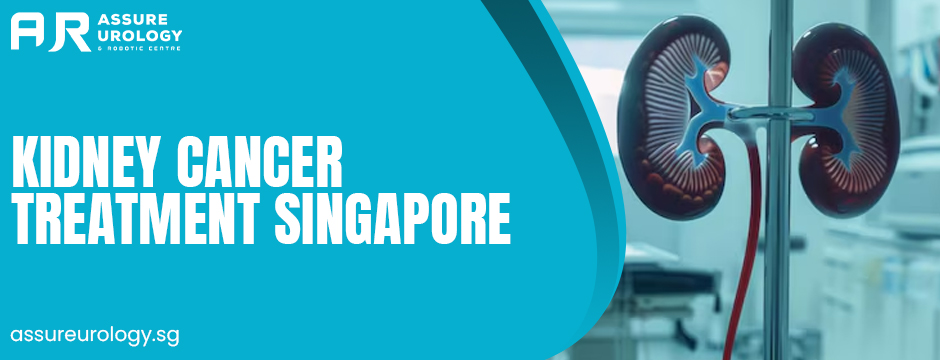Over the past two decades, Singapore has emerged as a global hub for advanced medical care, particularly in the field of urologic oncology. Among the most significant innovations is robotic-assisted kidney cancer surgery in Singapore, which has transformed the way surgeons remove renal tumors. By combining the precision of robotics with the expertise of specialized urologists, patients now benefit from minimally invasive procedures that reduce postoperative pain and speed up recovery. This particular blog delves into the evolution, benefits, and future outlook of robotic-assisted nephrectomy in Singapore’s leading medical centers.

1. Understanding Kidney Cancer and the Importance of Early Surgery
Kidney cancer—most commonly renal cell carcinoma—accounts for approximately 3–4% of adult malignancies. Early-stage disease often presents with subtle symptoms: blood in the urine (haematuria), unintended weight loss, loss of appetite, or anaemia. When detected early, the prognosis is excellent, with surgery offering curative potential. As such, prompt consultation with a urologist is vital if you experience any warning signs.
In Singapore, kidney cancer surgery remains the cornerstone of treatment for localised tumours. Whether performed via traditional open methods, laparoscopically, or with robotic assistance, complete tumour excision is critical to long-term survival. Yet, the advent of robotic platforms has redefined surgical standards, marrying oncologic efficacy with enhanced patient comfort.
2. Evolution of Surgical Techniques in Singapore
Historically, open radical nephrectomy was the gold standard for kidney cancer resection. This involved a large flank or abdominal incision, removal of the entire kidney, perinephric fat, and sometimes adjacent structures. While effective, open surgery was associated with significant pain, extended hospital stays (often 7–10 days), and a prolonged convalescence.
Laparoscopic nephrectomy began to gain traction in the early 2000s in Singapore’s tertiary hospitals. Through small keyhole incisions, surgeons could visualise and excise tumours with reduced blood loss and faster recovery, typically a three- to five-day hospital stay. Yet, laparoscopy had limitations: two-dimensional vision, constrained instrument articulation, and steep learning curves.
Enter robotic-assisted platforms in the late 2010s. These systems, first adopted by Singapore General Hospital and Parkway Cancer Centre, offered 3D magnified vision, wristed instruments with seven degrees of freedom, and ergonomic console controls. What was once a pioneering technology became the new benchmark for minimally invasive kidney cancer surgery in Singapore.
3. The Robotic-Assisted Nephrectomy: Technology and Technique
Robotic-assisted kidney cancer surgery in Singapore utilises systems such as the da Vinci Surgical System. The patient is positioned laterally, and four to five small ports (8–12 mm) are placed along the flank. One port accommodates a high-definition 3D camera; the others house robotic instruments—graspers, scissors, and energy devices. A bedside assistant manages suction, retraction, and specimen retrieval.
Key steps include:
- Renal Hilar Dissection: Precise isolation of the renal artery and vein.
- Tumour Resection or Nephrectomy: Depending on size and location, either partial (nephron-sparing) or radical nephrectomy is performed.
- Specimen Extraction: The excised tissue is bagged and removed through a small extension of one port or via a specially designed retrieval pouch.
- Pagsara: Port sites are closed in layers, minimising scarring.
Throughout, the console surgeon enjoys tremor filtration, motion scaling, and unparalleled dexterity, translating into meticulous dissection around delicate structures.
4. Advantages Over Conventional Approaches
Compared to open surgery and standard laparoscopy, robotic-assisted kidney cancer surgery offers multiple benefits:
- Reduced Postoperative Pain: Smaller incisions and less muscle cutting translate to lower analgesic requirements and better patient comfort.
- Shorter Hospital Stay: Many patients are discharged within 2–3 days postoperatively versus up to 10 days for open procedures.
- Quicker Return to Daily Activities: Most individuals resume light physical activity within 1–2 weeks, compared to 4–6 weeks after open surgery.
- Superior Precision in Tumour Excision: The high-definition 3D view and wristed instruments facilitate delicate parenchymal suturing during partial nephrectomy, preserving maximum healthy kidney tissue.
- Cosmetic Outcomes: Tiny port-site scars are barely noticeable, an important consideration for many patients.
5. Patient Selection and Personalised Care
Not every patient is an immediate candidate for robotic-assisted kidney cancer surgery in Singapore. Suitability depends on tumour characteristics, patient factors, and surgeon expertise:
- Tumour Size and Location: Ideal for lesions ≤7 cm (T1 stage) and favourably located on the kidney’s periphery. Central, hilar, or large tumours may still warrant open or hybrid approaches.
- Patient Health Status: Morbid obesity, extensive prior abdominal surgeries, or significant cardiopulmonary comorbidities may pose increased anaesthetic risk.
- Renal Function: Preexisting chronic kidney disease calls for nephron-sparing techniques whenever ontologically safe.
- Surgeon Experience: High-volume robotic centres with structured training programs yield the best outcomes; many Singapore hospitals mandate specialised fellowships before credentialling.
In practice, multidisciplinary tumour boards—including urologists, radiologists, pathologists, and medical oncologists—review each case. The shared decision-making model ensures personalised treatment plans aligned with patient values and clinical indications.
6. Integrating Multimodal Therapy
While surgery is curative for localised renal tumours, advanced-stage or metastatic kidney cancer may require adjunctive treatments. Singapore’s comprehensive cancer centres offer seamless integration of:
- Targeted Therapy: Agents such as tyrosine kinase inhibitors to block tumour angiogenesis.
- Immunotherapy: Checkpoint inhibitors to enhance anti-tumour immune responses.
- Adjuvant Trials: Patients with high-risk features may enrol in clinical studies evaluating novel combinations of surgery plus systemic therapy.
By collaborating across specialities, Singapore’s medical teams optimise outcomes for complex cases and uphold the highest standard of Kidney Cancer Treatment Singapore.
7. Preparing for Robotic-Assisted Surgery
A successful robotic nephrectomy begins well before the operating room. Preoperative preparation typically includes:
- Detailed Imaging: Contrast-enhanced CT or MRI to map tumour dimensions and vascular anatomy.
- Laboratory Evaluation: Complete blood count, renal function tests, coagulation profile, and crossmatching if needed.
- Anaesthetic Assessment: Cardiopulmonary clearance, particularly for elderly or comorbid patients.
- Patient Education: Discussion of risks (bleeding, infection, conversion to open surgery), expected recovery trajectory, and postoperative lifestyle modifications.
Enhanced Recovery After Surgery (ERAS) protocols are increasingly adopted, emphasising optimised pain control, early mobilisation, and nutritional support to hasten discharge and reduce complications.
8. Postoperative Care and Monitoring
After robotic-assisted kidney cancer surgery, patients enter a structured recovery pathway:
- Immediate Postoperative Period: Monitoring in a high-dependency unit for 12–24 hours; early ambulation and removal of drains/Foley catheters as soon as feasible.
- Pamamahala ng Sakit: Multimodal analgesia—combining non-opioid medications with localised nerve blocks—minimises narcotic use.
- Diyeta at Aktibidad: Clear fluids resume on the day of surgery, advancing to a regular diet by day two. Light walking is encouraged within hours of surgery.
- Follow-Up Imaging: Ultrasound or CT scan at three to six months to ensure no residual or recurrent disease.
- Long-Term Surveillance: Annual check-ups for at least five years, including renal function assessment and imaging as indicated.
Singapore’s leading urology clinics leverage digital health platforms, enabling remote monitoring of vital signs and seamless communication between patients and care teams.
These metrics solidify robotic-assisted kidney cancer surgery in Singapore as a safe, effective, and patient-centric option.

9. Training and Accreditation in Robotic Surgery
To sustain excellence, Singapore has invested in dedicated robotic surgery training programs:
- Simulation Labs: Surgeons hone console skills on virtual reality platforms before live cases.
- Proctorship and Fellowship: Visiting experts provide mentorship during the initial rollout of new robotic systems.
- Credentialing Bodies: The Ministry of Health and professional societies require evidence of case volume, outcomes auditing, and continuing education.
This rigorous framework ensures that every patient encountering robotic-assisted kidney cancer surgery in Singapore is treated by a thoroughly vetted team.
10. Future Directions and Innovations
Robotic platforms continue to evolve:
- Single-Port Robotics: Allowing procedures through a single incision hidden in the umbilicus, further enhancing cosmesis.
- Augmented Reality Integration: Overlaying preoperative imaging onto the surgical view to guide precise tumour excision.
- Artificial Intelligence: Real-time analytics to warn against unsafe movements or predict bleeding risks.
- Tele-mentoring and Remote Surgery: Bridging expertise across geographic locations, positioning Singapore as a regional training hub.
These innovations promise to broaden the indications and accessibility of robotic-assisted kidney cancer surgery in Singapore.
Final Thoughts
Robotic-assisted kidney cancer surgery in Singapore represents a quantum leap in urologic oncology. By blending state-of-the-art robotics with the clinical acumen of Singapore’s top urologists, patients receive gold-standard care that maximises cure rates while minimising pain, scarring, and recovery time. From stringent patient selection to enhanced recovery pathways and robust accreditation programs, every facet is designed to uphold surgical excellence. As technology continues its rapid march forward, Singapore stands poised to lead the Asia-Pacific region—and indeed the world—in delivering minimally invasive, precision-driven solutions for kidney cancer patients. For anyone facing a diagnosis, discussing robotic options with a specialist offers the best path toward a swift, safe, and successful outcome.
At Assure Urology at Robotic Center, patients receive world-class care under the expert hands of Dr. Terence Lim, who has performed over 700 robotic surgeries. Specialising in kidney cancer surgery in Singapore, the centre offers advanced treatments for urological conditions, including prostate, bladder, and kidney disorders, with precision and compassion.
FAQs
1. What makes robotic-assisted kidney cancer surgery better than traditional methods?
Robotic-assisted surgery offers improved precision, smaller incisions, less postoperative pain, and faster recovery compared to open surgery. It’s especially effective in removing kidney tumours with minimal impact on surrounding tissues.
2. Is robotic kidney cancer surgery suitable for all patients?
Not all patients are candidates for robotic surgery. Your urologist will assess your condition, cancer stage, and overall health to determine if robotic-assisted surgery is the most suitable option for you.
3. How soon can I recover after robotic kidney cancer surgery in Singapore?
Most patients experience a faster recovery with robotic surgery, typically returning to normal activities within 2 to 3 weeks, compared to 4 to 6 weeks for open surgery.


